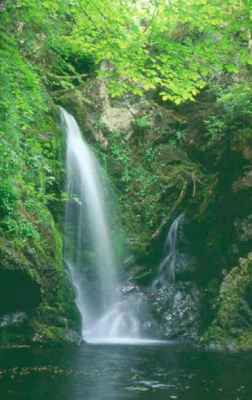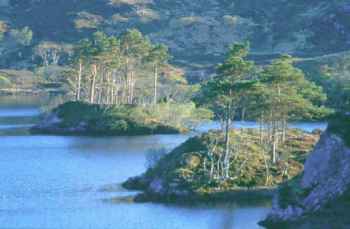|
FOREST & WOODLAND
Semi-natural woodland In the uplands, a limited range of tree species thrive on infertile, often peaty soils, and management is constrained by exposure and difficulty of access. Native woods here are typically unfenced, confined to steeper slopes and bounded by low-intensity grazing, with considerable potential for expansion by natural regeneration. On more fertile sites in the coastal lowlands and straths, and particularly in the South-East, woodlands have a wider suite of dominant tree species, and a correspondingly richer ground flora and more diverse canopy structure. These woodlands are often bounded by more intensive agricultural land uses, and have limited scope for natural expansion.
Sutherland’s diverse forests and woodlands have the potential to deliver a broad range of social, economic and environmental benefits to local communities and society at large. The use of forests and woodlands for recreation has increased, and many communities now seek to play a greater part in their management and even take on ownership. The long-term future of woodlands in Sutherland depends on the continuing delivery of a range of benefits, and the challenge to woodland managers is to balance the needs of recreation, local employment and habitat provision for wildlife. Upland birchwoods The most common native woodland type in Sutherland is typically found on acid, peaty soils on valley sides or at the margins of blanket mires and hillslope and valley-side flushes. Downy birch is usually the dominant tree, forming a open and often rather decrepit canopy, with a field layer of purple moorgrass and various sphagnum moss species. Various willow species colonise sites too wet for birch, and common alder is often present beside streams and flushes where the nutrient status is higher. On drier ground, rowan is common, holly and hazel are found on pockets of better soils, and juniper in open spaces. Wood sorrel often carpets the ground, and the heathy field layer contains an abundance of mosses and liverworts, especially in rocky terrain or sunless gorges. Upland oakwoods (NVC: W11) Key sites: Ardvar and Loch a’Mhuillin, Strathfleet, Ledmore. Oakwoods are found on more fertile soils, sessile or hybrid oak assumes dominance, with stands of aspen (on wetter sites) and hazel, and wych elm, birch, rowan, hawthorn and holly in the understorey. The drier eastern oakwoods have often become overrun by bracken, though bluebells may provide a spring carpet. The wetter Atlantic oakwoods, occupy humid valleys and gorges providing ideal conditions for many moss and lichen species. Other western coastal woodlands such as the aspen and hazel woods at Achmelvich and elsewhere is Assynt contain important oceanic lichen and bryophyte communities. |
Pinewoods (NVC: W18) Key sites: Amat, Alladale, Fairy Glen. Pine woodland is only found on poor, usually thin and well drained soils in Scotland north of the Central Belt. Downy birch and rowan are usually important components of the woodland, with juniper common. The ground flora is usually heather, with blaeberry, cowberry and often extensive carpets of mosses. Twinflower, and oneflowered wintergreen are important species that are found in the managed plantation at Balblair Wood. Wet Woods (NVC: W4/W7) Key sites: Wet woods are characterised by seasonal
waterlogging, and are usually found on very flat sites, such as estuarine
and bog margins. Alder is often the dominant species, with willows, aspen
and
Riparian or ‘waters edge’ woodlands are tremendously important from a biodiversity and river management perspective. Trees help stabilise banks, provide shade and the invertebrates and leaf matter form the basis to the aquatic food chain. Upland Ash Woodland (NVC: W9) This woodland type is found on the most fertile soils in the region, and consequently has been much reduced in extent by agriculture. Ash, alder, wych elm, hazel, downy birch, sessile oak, rowan, hawthorn, aspen, bird-cherry and holly will all be found, over a rich and varied ground flora, although the mixture at any site will usually reflect past management practices. Native woodlands form part of the designated
criteria for 26 Sites of Special Scientific Interest, and are an important
component of several National Nature Reserves and National Scenic Areas.
There are 4 Special Areas of Conservation for woodland in Plantation forestry Better soils and more sheltered sites in the South East of Sutherland allow larch, Scots pine, Douglas fir, western red cedar and western hemlock to be managed according to a range of silvicultural systems. Some conifer plantations are rich in associated fungi, and significant opportunities exist for improving biodiversity through restructuring to create more open space within woodlands, planting with broadleaves and, in some situations, tree removal and reversion to bog habitats. New native woodlands were encouraged by the Woodland Grant Scheme and Crofter Forestry Act, and have accounted for the majority of recent new planting in the county. Species choice and planting design are intended to simulate natural woodlands, and frequently incorporate significant areas of open ground: downy birch, willow, rowan and alder are the most frequently planted species in Sutherland. These woodlands will produce little if any timber, but are expected to develop considerable value for biodiversity, amenity and recreation in the future. Policy woodlands are typically small plantings,
often from the 19th Century, associated with large houses and fertile,
sheltered sites. Characterised by a wide range of exotic broadleaf and
conifer species |

